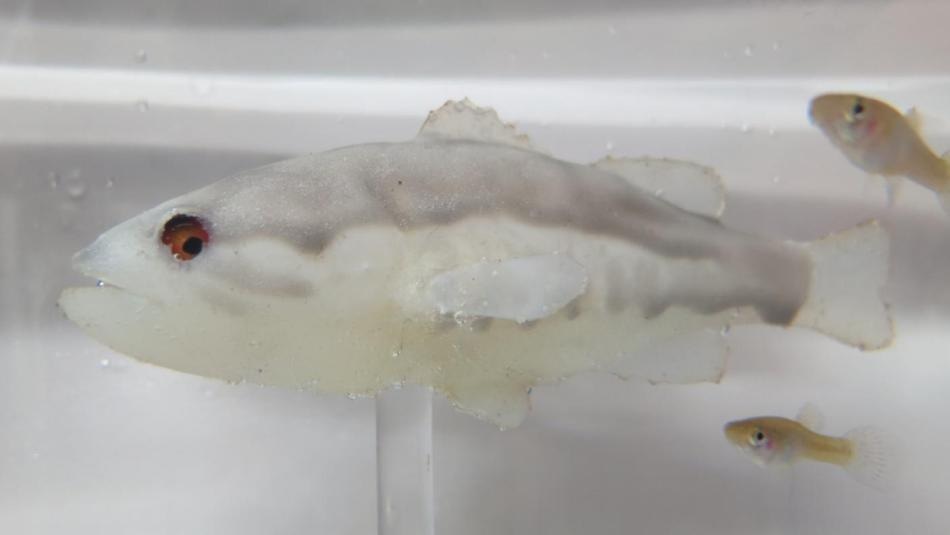Sep 17 2019
The control of invasive species can be a tremendously difficult task, particularly in rivers and lakes where numerous wildlife species, including native fish, do not have many options to escape.
 A robot fish that mimics a predator largemouth bass may be a valuable tool in the fight against one of the world’s most problematic invasive species, the mosquitofish. (Image credit: NYU Tandon School of Engineering)
A robot fish that mimics a predator largemouth bass may be a valuable tool in the fight against one of the world’s most problematic invasive species, the mosquitofish. (Image credit: NYU Tandon School of Engineering)
The laboratory of Professor Maurizio Porfiri from NYU Tandon School of Engineering has recently used biomimetic robots to learn and change animal behavior. In this regard, Professor Porfiri headed an interdisciplinary research team from the University of Western Australia and NYU Tandon to illustrate how robotic fish can serve as a useful tool to fight against mosquitofish—one of the most challenging invasive species in the world.
Mosquitofish can be found in freshwater rivers and lakes across the world. Their growing populations have affected the populations of amphibians and native fish. Although efforts have been made in the form of trapping or toxicants to control the population of these species, they usually fail or affect the local wildlife.
Porfiri and a group of collaborators have reported the initial experiments to estimate the potential of a biologically inspired robotic fish and how it can be used to promote fear-related modifications in mosquitofish.
The researchers’ findings suggest that even short exposure to a robotic model of the largemouth bass—the primary predator of mosquitofish—can induce significant stress responses in the fish. This may trigger physiological changes and avoidance behaviors related to the loss of energy reserves and possibly translate into lower reproduction rates.
The paper titled “Behavioural and Life-History Responses of Mosquitofish to Biologically Inspired and Interactive Robotic Predators” has been reported in the current issue of the Journal of the Royal Society Interface.
To the best of our knowledge, this is the first study using robots to evoke fear responses in this invasive species. The results show that a robotic fish that closely replicates the swimming patterns and visual appearance of the largemouth bass has a powerful, lasting impact on mosquitofish in the lab setting.
Maurizio Porfiri, Professor, NYU Tandon School of Engineering
Groups of mosquitofish were subsequently exposed to a robotic largemouth bass for six consecutive weeks, with each week involving a 15-minute session. It was observed that the behavior of the robot differed between trials, ranging to several degrees of biomimicry.
In certain trials, the robot was particularly programmed to integrate real-time feedback on the basis of interactions with live mosquitofish, and also to display “attacks” that are usual of the predatory behavior—that is, a quick increase in swimming rate.
Following this, interactions between the robotic model and the live fish were monitored in real time and then examined to expose the associations between the level of stress response displayed by the live fish and the level of biomimicry in the robotic model.
In mosquitofish, fear-related behaviors include irregular swimming patterns, hesitancy in exploring open and unfamiliar spaces that are possibly dangerous, and freezing (not swimming).
In addition, the scientists determined physiologic parameters of stress response in the fish. To do this, they anesthetized the fish on a weekly basis and determined their length and weight. Reduced weight denotes a more robust anti-predator response and leads to lower energy reserves.
Fish that have lower reserves may not survive for a long time and are less likely to devote energy toward upcoming reproduction—factors that hold strong implications for managing populations in wildlife.
Fish subjected to robotic predators that nearly simulated the aggressive, attack-oriented swimming patterns of real-life predators showed maximum levels of physiological and behavioral stress responses.
Further studies are needed to determine if these effects translate to wild populations, but this is a concrete demonstration of the potential of robotics to solve the mosquitofish problem. We have a lot more work going on between our schools to establish new, effective tools to combat the spread of invasive species.
Giovanni Polverino, Study Lead Author and Forrest Fellow, Department of Biological Sciences, University of Western Australia
The Dynamical Systems Laboratory of Professor Porfiri is recognized for earlier work using biomimetic robots together with live fish to tease out the mechanisms of several collective animal behaviors, such as mating preferences, leadership, and also the effect of alcohol on social behaviors.
The biomimetic robots—apart from providing fully controllable stimuli for analyzing animal behavior—reduce the use of experimental animals.
The co-authors of the paper also include Mert Karakaya, NYU Tandon doctoral student; Chiara Spinello, a researcher in Porfiri’s laboratory; and Vrishin Soman, NYU Tandon undergraduate student.
Professor Porfiri holds faculty appointments in NYU Tandon’s Department of Biomedical Engineering and Department of Mechanical and Aerospace Engineering. The National Science Foundation and the Forrest Research Foundation funded the study.
Video Robot & Mosquitofish
A biomimetic robot that mimics the appearance and locomotion of the predator largemouth bass depleted the energy reserves of the invasive mosquitofish after only 15 minutes of exposure weekly. (Video credit: Maurizio Porfiri and Giovanni Polverino)